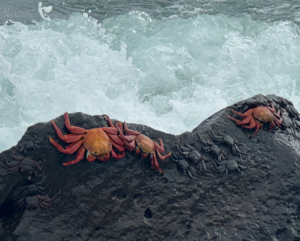Turtles are bizarre animals. Is anything quite like a turtle? Their slow-motion living makes us think of them as pensive, wise, and deliberate. The self-protective shell feels like a metaphor for introverts everywhere. They’ve always been one of my favorite animals, so seeing the giant tortoises on the Galápagos has been on my bucket list since long before I knew what a bucket list was. I’ve been a fully functioning adult for some time now, but I’d been putting off bucket list travel until I had a partner to share it with. A few years ago, I decided I’d probably better stop postponing and start ticking items off the life list. This year I decided to check off a big one and I spent over two weeks on the Enchanted Isles.
The archipelago lies over 600 miles off the coast of Ecuador and hosts a curious collection of animals, including the world’s largest tortoises, the only marine lizards, the only flightless cormorants, the only flamingos in the Pacific, and the only penguins found north of the equator. Since Charles Darwin visited in 1835 on the Beagle, the Galápagos have loomed iconic for professional and amateur naturalists. Darwin’s observations of similar but different forms of tortoises, mockingbirds, and finches on the different islands profoundly affected his thoughts about animal species and how they came to be. He noticed how the shapes to tortoise shells varied dramatically depending on the type of vegetation on their respective host islands. He was struck by the differences between mockingbirds on adjacent islands. Why would they be different from each other? Why wouldn’t they all be the same? His collection of small songbirds, all similar in plumage but very different in beak shape, made his ornithologist colleague, John Gould, conclude that they were all different types of finches. Darwin theorized that long ago one species of tortoise, one species of mockingbird, and one species of finch colonized these isolated islands and then over hundreds of thousands of years, each slowly changed in independent directions due to unique environments on each island, eventually resulting in different species.

Darwin felt that these changes were incremental and that immense amounts of time with steady selective pressures were needed to eventually cause noticeable changes. He observed examples elsewhere of changes that happen quickly. More recent work by other scientists on the Galápagos has demonstrated that short, intense selective life forces, like a drought or monsoon season, can cause noticeable changes in a species in a matter of a few generations. Life, as it turns out, is remarkably plastic.
This principle will be an obvious one for dog breeders. Over a shorter time period humans have taken wolves and created Basset Hounds, Great Danes, Bichon Frisés, and French Bulldogs. Even within a human lifetime, dedicated breeders focus on perfecting a “type” of their selected breed within their kennel. We know the power of selection and use it to try to create better, healthier dogs with each breeding.
On another level, selective pressures also work within individuals. Lord Tennyson wrote, “I am a part of all that I have met.” Some steady pressures change us over a lifetime, some dramatic pressures or events can change everything in a moment. I’m not the same person I was 40 years ago watching Mutual of Omaha’s Wild Kingdom, dreaming of visiting the Galápagos. Innumerable selective pressures, big and small, have shaped the person I am, the person I am still becoming. Just like evolutionary forces work on the wildlife of the Galápagos, and just like selective breeding works on a line of dogs, life works on each of us and we all respond and adapt.




